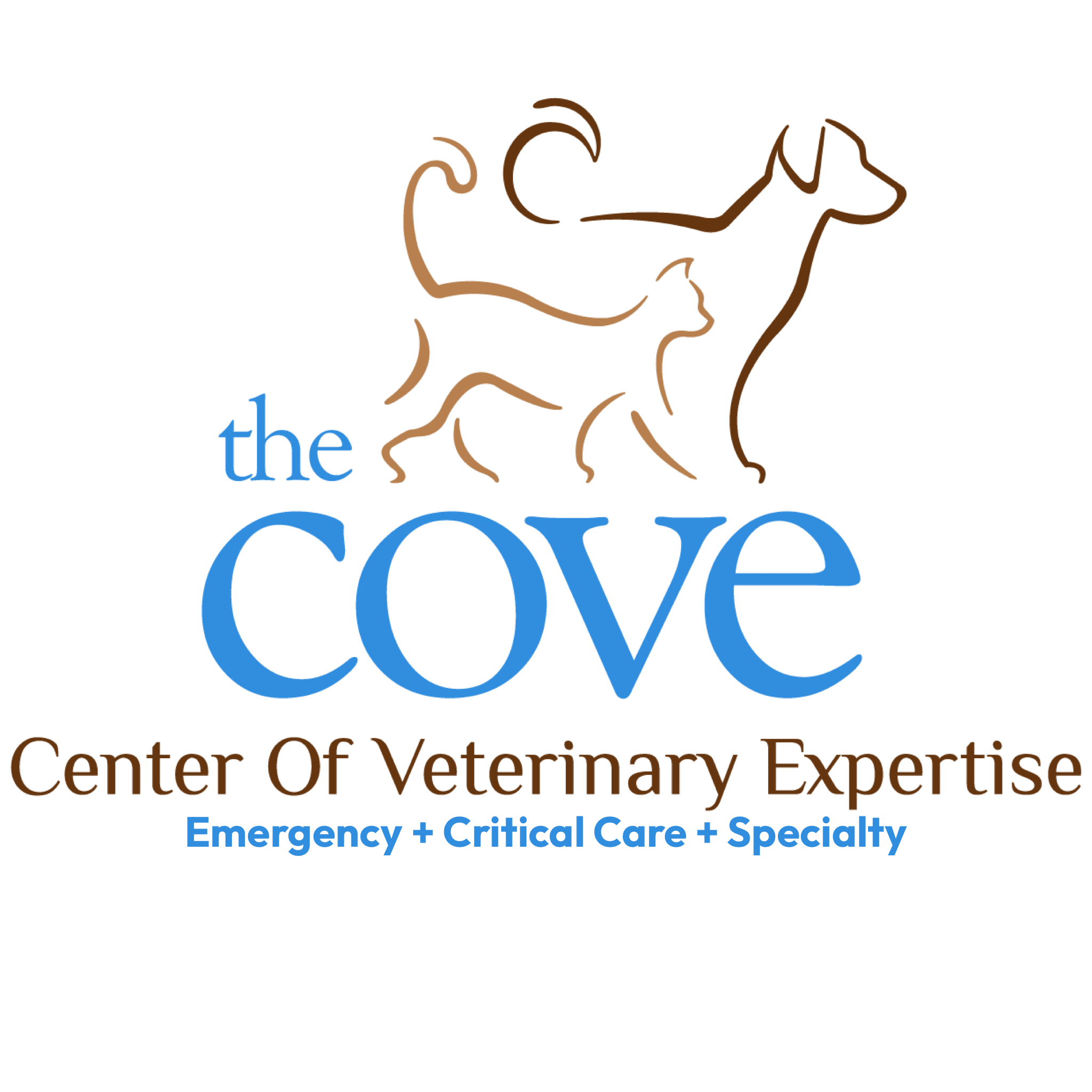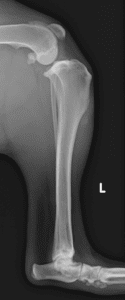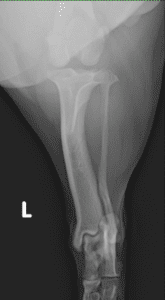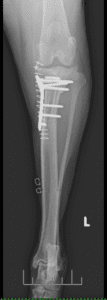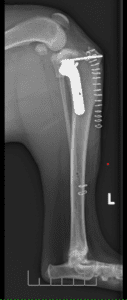By Brandy Sinclair, LVT
Was your pet just diagnosed with a cranial cruciate ligament tear? If so, you are not alone; unfortunately, cranial cruciate ligament (CCL) ruptures are the most common injury diagnosed within the veterinary field. This blog will explain the cause of cranial cruciate ligament disease, the most common treatment, recovery process, and what to expect after full recovery.
What Causes CCL Injuries?
Most cranial cruciate injuries occur due to chronic conditions, rather than acute injuries or trauma. The cranial cruciate ligament connects two bones, the femur and the tibia, and lies across the stifle or “knee” of your pet’s hind legs. CCL disease means the ligament weakens (degenerates) over time, most commonly due to genetic, conformational, and/or immune-mediated processes within the joint. Continued use of the limb causes micro-injuries to the ligament that cause the weakening over time. In addition, the already weakened ligament could potentially tear after strenuous activity or injury to the limb, which may result in your dog’s sudden lameness or limping.
How Are CCL Injuries Treated?
As CCL ruptures or tears are the most common injury seen by veterinary surgeons, surgical fixation of the stifle is the most common surgical procedure performed by board-certified surgeons like Jeff Stallings, DVM, DACVS at The COVE. While multiple surgical treatments exist, the tried-and-true procedure most commonly performed is the tibial plateau leveling osteotomy (TPLO). Many boarded veterinary surgeons consider TPLO to be the most successful stabilization procedure available for dogs of any size, but especially for large breeds.
The TPLO procedure changes the way the stifle joint operates, rather than repairing or replacing the torn ligament. In a normally functioning stifle, an intact CCL prevents the femur from “sliding” down the slope of the tibia when a dog moves. When the CCL is ruptured, the femur can slide down the slope, allowing the tibia to move forward when weight is placed on the affected limb. This condition is known as a cranial drawer. In a TPLO procedure, the tibia bone is cut and rotated, creating a flatter slope, preventing the femur from sliding backward. A metal plate is screwed to the inside of the tibia to stabilize the osteotomy.
- Lrl Lateral View
- Lrl Vd View
- Tplo Vd
- Tplo Lateral
What Happens After TPLO Surgery?
The most important aspect of a successful recovery from TPLO surgery is following a strict recovery process at home, followed by rehabilitation. Because the procedure essentially creates a fracture site of the bone, it is important to keep your pet as still as possible, as much as possible. It takes roughly six weeks for the bones to heal completely, so it is recommended to confine your pet to a crate during that time. Brief potty breaks with sling support are allowed several times a day. We know that sounds extreme, but strictly limiting movement is the only way to ensure your dog heals properly.
During your dog’s follow-up visits with the surgeon, they will take X-rays to confirm the bone has healed. Once it has, your dog can begin physical therapy at home, generally consisting of a gradual return to normal activity. Most pets can resume normal activity after 3-4 months. However, this part cannot be rushed. If you don’t help your dog adhere to their exercise restrictions, they could experience severe complications, including the need for additional surgery.
Additionally, to prevent infection, it is important to leave the Elizabethan collar on your pet at all times. We know they hate it, but the collar is the best way to prevent your dog from licking or chewing their wound. After the incision has fully healed, the e-collar will no longer be required, typically three weeks post-operatively.
Due to the nature of the degenerative disease associated with CCL tears, your dog may experience some changes after recovery. In severe cases, returning to full activity may not be feasible. Stiffness in cooler weather, or when they first get up after long periods of rest, may be noted. It is also not uncommon for dogs to tire more easily after exercise, so you may need to modify their level of activity. Your surgeon will discuss this at your consult.
In conclusion, while the TPLO procedure is highly successful, the majority of success stems from ensuring that you’re complying with your surgeon’s instructions in the days and weeks afterward. At The COVE, we will be in frequent contact with you providing a customized post-operative plan, medications, and educational support to ensure your pet’s recovery process is as smooth as it can be.
If you have questions or want to discuss your pet’s case with one of our board-certified surgeons, give us a call at (757) 935-9111.
About Us
The COVE’s veterinarians and staff wholeheartedly embrace the core values of community, collaboration, commitment, compassion, and integrity. This focus ensures that pets, the people who love them, and their primary care veterinarians have as positive and affirming a healthcare experience as possible, regardless of the circumstances that bring us all together.
